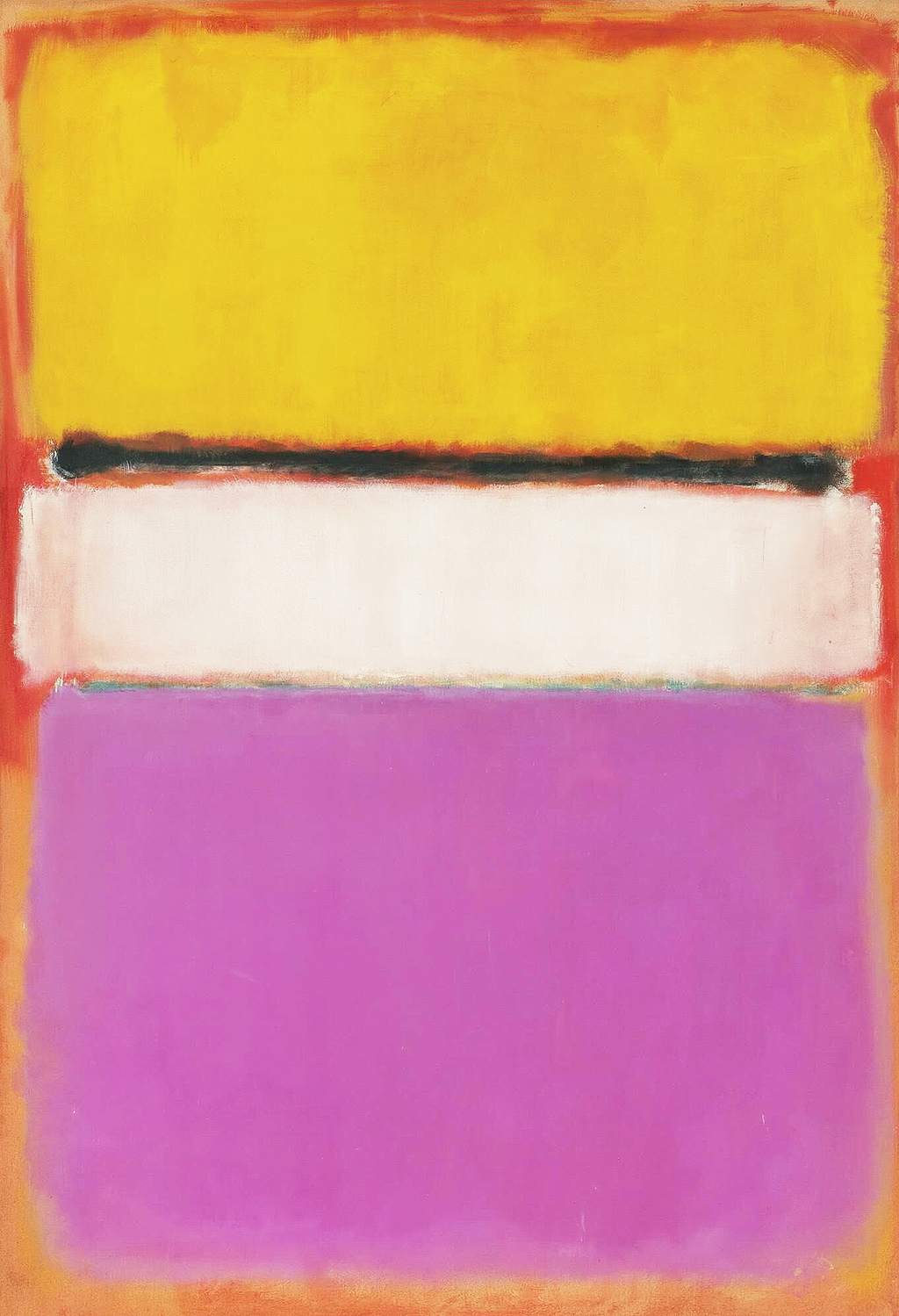Mark Rothko Art Emmprisiosm White Center Yellow Pink and Lavender on Rose
White Center (Yellow, Pinkish and Lavander on Rose) is function of Mark Rothko's signature multiform style: several blocks of layered, complementary colors on a large canvass.
The painting is from tiptop to lesser, a yellow horizontal rectangle, a black horizontal strip, a narrow white rectangular band and the lesser one-half is lavender. The pinnacle half of the rose ground is deeper in colour and the bottom half is stake. White Center is oft referred to as White Eye (xanthous pinkish and lavender on rose) and it measures 205.8 ten 141 cm. Marking Rothko continued to simplify the compositional elements of his paintings. In 1950, he began to carve up the canvas into horizontal bands of colour. Despite the frontal composition and absence of spatial illusionism in these works, the broad bands of color announced simultaneously to float in front of the motion-picture show plane and to merge with the color field upon which they are place, as in White Heart (xanthous pinkish and lavender on rose), 1950.
A luminosity results from the repeated layering of thin washes of paint, which allows some underpainting to bear witness through the upper coats. In each work of this period, Rothko sought only subtle variations in proportion and color, even so achieved within this limited format a broad range of emotions and moods. The photo at the top displays this painting's supreme colour choices, namely yellow, pink and lavender on rose. The work was sold in May 2007 by Sotheby's on behalf of David Rockefeller to the Royal family of Qatar; Sheikh Hamad bin Khalifa Al-Thani, and his wife, Sheikha Mozah bint Nasser Al-Missned. The painting sold for 72.84 meg (USD), setting the record of the current most expensive post-war work of art sold at sale.
The colour field movement would commence in the 1940s and so past the fourth dimension this painting was completed, information technology had already been flourishing for several years. Rothko was to get the near famous fellow member of this group, simply was far from the just fellow member of information technology. He also worked in other styles before in his career but these tend to be forgotten inside most exhibitions of his work. Some of the artist's most meaning paintings came at around the aforementioned fourth dimension as White Center (Yellow, Pinkish and Lavender on Rose), with this untitled painting from 1952, too every bit Rust and Blue from a year subsequently. It is clear that Rothko played a significant role in developing American art and encouraging others to join the contemporary art scene which was truly flourishing.
The artist'southward intention with this manner of painting was always to engulf the viewer in colour. He wanted u.s.a. to stand up for sometime looking at each of his paintings, rather than simply looking quickly as nosotros pass by. Taking more than time will help us to appreciate his work in person, as many of these colour field paintings also have different techniques used across the sheet that you perhaps would not be enlightened of from smaller photographs of the original. The utilise of vivid, contrasting colours such as yellow, purple and white has made this a popular choice equally an fine art print reproduction too. The aforementioned can also be said for Orange and Yellow and Orange, Red, Xanthous, which contain a similar level of brightness and saturation. Despite the qualities of the painting that we discuss in this section, it has been used less oft in exhibitions than many of his related paintings. Many of Rothko'south piece of work would intially exist seen in smaller local galleries inside New York earlier being unveiled in larger institutions later on on. Information technology was of import for the artist not to just focus on fame with his career and remain apprehensive throughout.
As is typical of the creative person, the back of the canvas is signed and dated. The painting measures 81 x 55 1/2 in. (205.8 10 141 cm). According to the records that remain on this slice, it seems to have only left the United States once, prior to being purchased at auction in 2007. It was featured in an exhibition in the late 1990s that travelled around to Washington DC, New York, and and then Paris, at the Musée d'Art Moderne. Prior to that information technology had appeared in an exhibition in Buffalo, 1960, so Massachusetts in 1985. Much of this information is from the catalogue raisonne of 1998 which has been revised recently. This lack of exposure left the piece relatively unknown until the boggling cost was achieved at sale in 2007. This has also fatigued attention from the mass media, who always seem interested in high priced sales, sometimes forgetting about the quality of the specific artwork itself.
White Center appeared just as Rothko had establish in fashion - this mode would then continue to the way to 1970, with the likes of Untitled (Black on Greyness), which was amongst his concluding pieces. Having experimented considerably throughout his career, particularly in the early periods when he was learning at a ferocious footstep, he seemed contented with the Colour Field approach and would only make subtle changes in the two decades that followed White Center. Academics have described this piece as a masterpiece, an example of how Rothko was in the early stages of maturity equally an artist. They specifically accept approved of the size and intensity of this piece which absorbs you whole. He had moved slowly towards abstration, little by picayune, in a similar fashion plant in the careers of artists like Miro and Mondrian. One new to his career only sees this finish result, rather than the considerable journeying that had been travelled in guild to get to this point.

0 Response to "Mark Rothko Art Emmprisiosm White Center Yellow Pink and Lavender on Rose"
Post a Comment